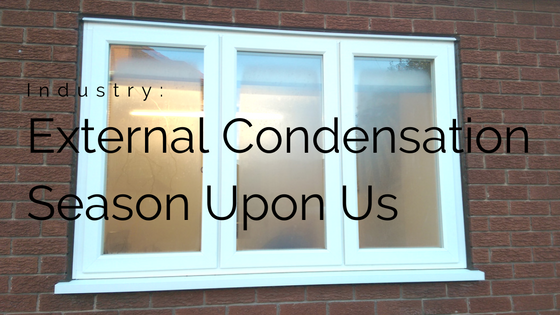We’re not even into September, and just the other morning I woke up to find external condensation on the outside of my windows. That’s the earliest I have seen it on my windows in quite a while. But it did confirm one thing, that external condensation season is just round the corner.
An annual tradition
With external condensation comes the phone calls from customers. I’m sure all installers have had them. Disgruntled home owners waking up in a morning to a view of a blurred everything, getting on the phone claiming that there is something wrong with their new windows.
Of course there isn’t anything wrong with them. It’s merely a symptom of the windows actually doing their job of keeping heat in. How is it caused? According to Pilkington:
The phenomenon is a natural and predictable event caused by the outer pane of the glazing being colder that the glass that it replaced. With single glazing and older style double glazing a larger proportion of heat was lost to the outside through the glass. With modern low-e glazed windows more of the heat is kept inside and the outer pane is not heated as much. Moisture condenses out of the air onto a cold surface that is said to be below the dew point. The dew point varies with the air temperature and the amount of moisture it contains. In Spring and Autumn in particular the glass temperature can fall to a low level during the night and the dew point can be comparatively high in these seasons. The glass is more often likely to be below the dew point in these conditions and the moisture condenses onto the surface.
So there you have the reason for external condensation. Perfectly reasonable. But if the industry went about educating the customer about this phenomenon from the start, rather than being reactive and waiting for home owners to call, then perhaps we wouldn’t have the regular-as-clockwork phone calls in the Spring and Autumn.
Education
For me, this issue is all about education. So far, I still believe that there has been very little. Awareness of this issues peaks in the Spring and Autumn parts of the year, as this is when it happens and home owners go online to find out more about it.
But then the issue goes away. It shouldn’t, but it does. I don’t think the internet is the best tool for educating home owners about external condensation either. As it’s seasonal, awareness peaks and troughs dependent on the time of year. The best thing we can do as an industry is make sure that home owners are explained on the phenomenon at the starts of the sales process.
If home owners know about the effects from the start, before windows and doors are installed, they know to expect it, understand it’s not a problem and installers should find that calls relating to external condensation are reduced.
Ways to beat it
For most people, external condensation isn’t an issue. It lasts for an hour or two in the morning and then it disappears. But there will be some out there who will be irritated by it to the point that they will pay more to ensure it doesn’t happen. So what are the options in the market place to get round external condensation?
Pilkington have developed their own Anti-Condensation glass to combat external condensation. Any glass fabricators using Pilks products should have it readily available. There will probably be an uplift cost-wise, but it shouldn’t be too much, and it should give installers an easily sourced workaround if it becomes an issue with a potential client.
Saint-Gobain have also brought their own product out, called SGG VIEWCLEAR® II, to combat external condensation.
Both of these products should get round the issue. But most home owners will probably not be all that enthused to spend more to avoid a problem that will only occur for a few weeks of the year. So we circle back to the point about education and nip any potential future phone calls in the bud.
Either way, external condensation is nearly here. Stand by your phones.
To get weekly updates from DGB sent to your inbox, enter your email address in the space below to subscribe:





